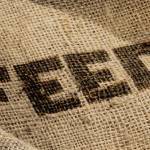Using Molasses in Horse Feeds

Many horse owners are concerned about feeding their horses molasses. Interestingly, molasses has about the same amount of nonstructural carbohydrate (NSC) as barley or corn. Most of this is in the form of either sucrose (glucose and fructose) or as free glucose and fructose. Both fructose and glucose are readily absorbed from the digestive tract, and fructose is converted into glucose by the liver. Therefore, molasses would result in an increase in blood glucose in a similar fashion to the digestion of starch.
In a trial at Kentucky Equine Research (KER), four Thoroughbreds were fed one of four meals:
(1) 1 kg (2.2 lb) of whole oats,
(2) 1 kg (2.2 lb) of cracked corn,
(3) 0.9 kg (2 lb) of oats + 0.1 kg (0.22 lb) of molasses, or
(4) 0.9 kg (2 lb) of corn + 0.1 kg (0.22 lb) of molasses.
Blood glucose was measured in these horses for four hours after feeding. The glycemic response of the horses when fed oats was nearly the same as when they were fed corn even though corn has 40% more NSC than oats. This is because the starch in oats is much more digestible than the starch in cracked corn.
Adding molasses to oats had little effect on glycemic response. Until three hours after feeding, the glucose curves were about the same for the two treatments. After three hours, glucose remained slightly elevated in the horses fed only oats. When molasses was added to corn, there was a large difference in glycemic response. Adding molasses to corn caused a large increase in glycemic response that was particularly pronounced in one horse.
Why adding molasses affected corn and oats differently may be explained by the rate with which the horses consumed each diet. When fed straight oats and corn, the horse’s average rate of intake was equal to 107 and 105 grams/minute, respectively. When molasses was added to oats, intake rose to 122 grams/minute, a 14% increase. When molasses was added to corn, rate of intake rose to 156 grams/minute, an increase of 49%. At this high rate of intake, the sugar in the molasses was digested rapidly, resulting in a large increase in blood glucose.
Combining molasses with a more digestible starch source (oats) with a lower rate of intake buffered the glycemic response of the molasses. Therefore, it appears that the way that molasses affects blood glucose in horses will depend to a large degree on what other NSC sources are in the feed and how quickly the horse eats its grain.








